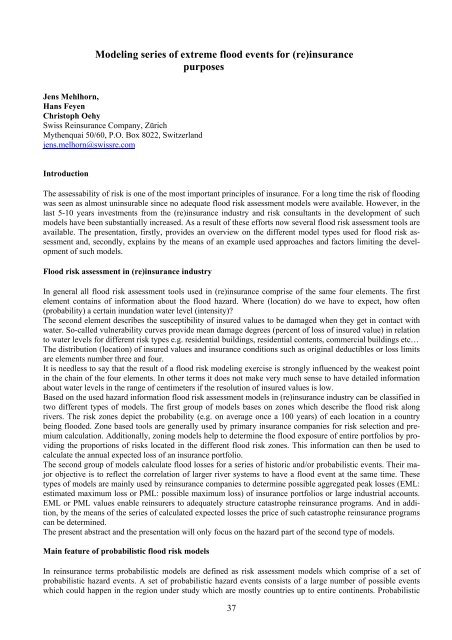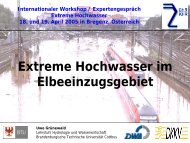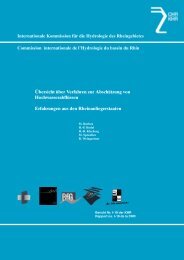ABSTRACTS 'Extreme Discharges' - CHR-KHR
ABSTRACTS 'Extreme Discharges' - CHR-KHR
ABSTRACTS 'Extreme Discharges' - CHR-KHR
You also want an ePaper? Increase the reach of your titles
YUMPU automatically turns print PDFs into web optimized ePapers that Google loves.
Modeling series of extreme flood events for (re)insurance<br />
purposes<br />
Jens Mehlhorn,<br />
Hans Feyen<br />
Christoph Oehy<br />
Swiss Reinsurance Company, Zürich<br />
Mythenquai 50/60, P.O. Box 8022, Switzerland<br />
jens.melhorn@swissre.com<br />
Introduction<br />
The assessability of risk is one of the most important principles of insurance. For a long time the risk of flooding<br />
was seen as almost uninsurable since no adequate flood risk assessment models were available. However, in the<br />
last 5-10 years investments from the (re)insurance industry and risk consultants in the development of such<br />
models have been substantially increased. As a result of these efforts now several flood risk assessment tools are<br />
available. The presentation, firstly, provides an overview on the different model types used for flood risk assessment<br />
and, secondly, explains by the means of an example used approaches and factors limiting the development<br />
of such models.<br />
Flood risk assessment in (re)insurance industry<br />
In general all flood risk assessment tools used in (re)insurance comprise of the same four elements. The first<br />
element contains of information about the flood hazard. Where (location) do we have to expect, how often<br />
(probability) a certain inundation water level (intensity)?<br />
The second element describes the susceptibility of insured values to be damaged when they get in contact with<br />
water. So-called vulnerability curves provide mean damage degrees (percent of loss of insured value) in relation<br />
to water levels for different risk types e.g. residential buildings, residential contents, commercial buildings etc…<br />
The distribution (location) of insured values and insurance conditions such as original deductibles or loss limits<br />
are elements number three and four.<br />
It is needless to say that the result of a flood risk modeling exercise is strongly influenced by the weakest point<br />
in the chain of the four elements. In other terms it does not make very much sense to have detailed information<br />
about water levels in the range of centimeters if the resolution of insured values is low.<br />
Based on the used hazard information flood risk assessment models in (re)insurance industry can be classified in<br />
two different types of models. The first group of models bases on zones which describe the flood risk along<br />
rivers. The risk zones depict the probability (e.g. on average once a 100 years) of each location in a country<br />
being flooded. Zone based tools are generally used by primary insurance companies for risk selection and premium<br />
calculation. Additionally, zoning models help to determine the flood exposure of entire portfolios by providing<br />
the proportions of risks located in the different flood risk zones. This information can then be used to<br />
calculate the annual expected loss of an insurance portfolio.<br />
The second group of models calculate flood losses for a series of historic and/or probabilistic events. Their major<br />
objective is to reflect the correlation of larger river systems to have a flood event at the same time. These<br />
types of models are mainly used by reinsurance companies to determine possible aggregated peak losses (EML:<br />
estimated maximum loss or PML: possible maximum loss) of insurance portfolios or large industrial accounts.<br />
EML or PML values enable reinsurers to adequately structure catastrophe reinsurance programs. And in addition,<br />
by the means of the series of calculated expected losses the price of such catastrophe reinsurance programs<br />
can be determined.<br />
The present abstract and the presentation will only focus on the hazard part of the second type of models.<br />
Main feature of probabilistic flood risk models<br />
In reinsurance terms probabilistic models are defined as risk assessment models which comprise of a set of<br />
probabilistic hazard events. A set of probabilistic hazard events consists of a large number of possible events<br />
which could happen in the region under study which are mostly countries up to entire continents. Probabilistic<br />
37





